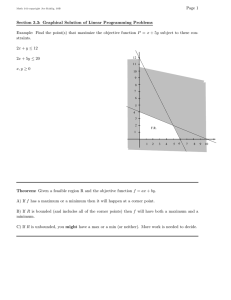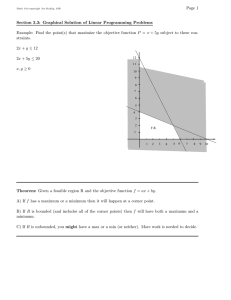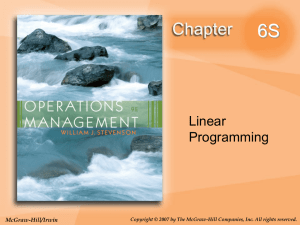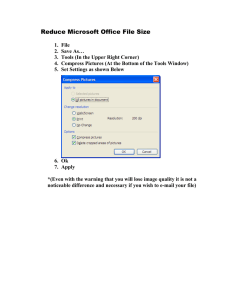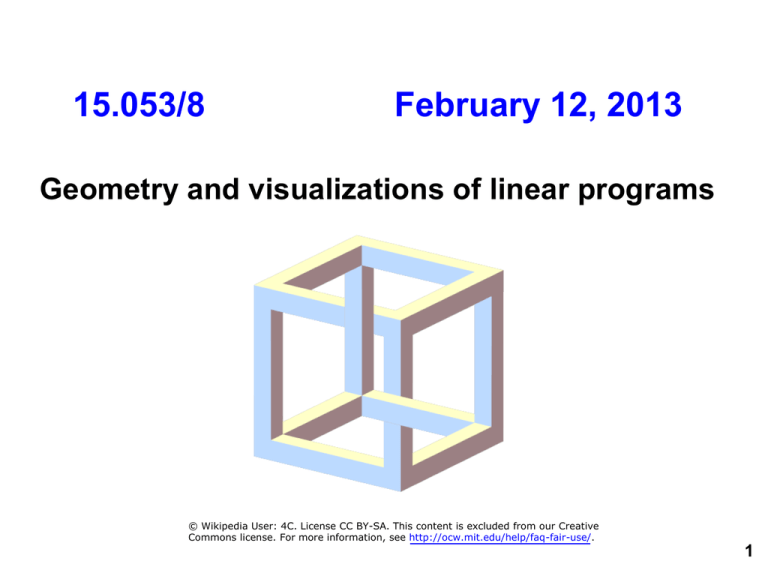
15.053/8
February 12, 2013
Geometry and visualizations of linear programs
© Wikipedia User: 4C. License CC BY-SA. This content is excluded from our Creative
Commons license. For more information, see http://ocw.mit.edu/help/faq-fair-use/.
1
Quotes of the day
“You don't understand anything
until you learn it more than one
way.”
Marvin Minsky
“One finds limits by pushing
them.”
Herbert Simon
2
Overview
Views of linear programming
– Geometry/Visualization
– Algebra
– Economic interpretations
3
What does the feasible region of an LP
look like?
Three 2-dimensional examples
4
Some 3-dimensional LPs
Courtesy of Wolfram Research, Inc. Used with permission. Source: Weisstein, Eric W.
"Convex Polyhedron." From MathWorld -- A Wolfram Web Resource.
5
Goal of this Lecture: visualizing LPs in 2 and 3
dimensions.
What properties does the feasible region have?
– convexity
– corner points
What properties does an optimal solution have?
How can one find the optimal solution:
– the “geometric method”
– The simplex method
Introduction to sensitivity analysis
– What happens if the RHS changes?
6
A Two Variable Linear Program
(a variant of the DTC example)
objective
z = 3x + 5y
3y
10
(1)
x +
2y
6
(2)
x +
y
5
(3)
4
(4)
3
(5)
x
y
x, y 0
Constraints
2x +
(6)
7
Finding an optimal solution
Introduce yourself to your partner
Try to find an optimal solution to the linear
program, without looking ahead.
8
Inequalities
y
A single linear inequality determines a unique
half-plane
5
x + 2y 6
4
3
2
1
1
2
3
4
5
6
x
9
Graphing the Feasible Region
Graph the Constraints:
2x+ 3y 10
(1)
x 0 , y 0. (6)
y
5
4
3
2x + 3y = 10
2
1
1
2
3
4
5
6
x
10
Add the Constraint:
x + 2y 6
(2)
y
5
4
3
2
x + 2y = 6
1
1
2
3
4
5
6
x
11
Add the Constraint:
x + y 5
A constraint is
called redundant
if deleting the
constraint does
not increase the
size of the
feasible region.
y
5
x + y = 5
4
3
“x + y = 5”
is redundant
2
1
1
2
3
4
5
6
x
12
Add the Constraints:
x 4; y 3
y
5
We have now
graphed the
feasible
region.
4
3
2
1
1
2
3
4
5
6
x
13
How many constraints are redundant?
1. One
2. Two
3. More than two
14
The geometrical method for optimizing 3x + 5y
y
3
Graph points such that 3x + 5y = p
for various values of p.
Choose p maximal
2
1
3x + 5y = 11
3x + 5y = 8
1
Isocost lines
2
3
4
x
15
y
3
Find the maximum value p such that there is a
feasible solution with 3x + 5y = p.
Move the line with profit p parallel as much as
possible.
3x + 5y = 16
2
1
The optimal
solution
occurs at a
corner point.
3x + 5y = 11
3x + 5y = 8
1
2
3
4
x
16
Another Problem
17
18
Mental Break
Trivia about US
Presidents
19
Different types of LPs
Infeasible LP’s:
that is, there is no
feasible solution.
max
Try tox develop an LP with one or
s.t.
x + y ≤ -1for each of the
two variables
x ≥ 0,three
y ≥ 0properties.
following
LPs that have an
optimal solution.
1.x it has no solution
max
s.t. 2. xit+has
y ≤ an
1 optimal solution
3. xthe
≥ 0,solution
y ≥ 0 is unbounded
LPs with
unbounded
objective. (For a
max problem this
means unbounded
from above.)
max x
s.t. x + y ≥ 1
x ≥ 0, y ≥ 0
20
Any other types
Theorem. If the feasible region is non-empty and
bounded, then there is an optimal solution.
This is true when all of the inequalities are “<=
constraints”, as opposed to “< constraints”.
e.g., the following problem has no optimum
Maximize
x
subject to 0 < x < 1
21
Convex Sets
y
3
2
A set S is convex if for every two points in the
set, the line segment joining the points is also in
the set; that is,
if p1, p2 ∈ S, then so is (1 - λ)p1 + λp2 for λ ∈ [0,1].
Theorem. The feasible
region of a linear program is
convex.
p1
1
p2
1
2
3
4
x
22
More on Convexity
Which of the following are convex ?
or not ?
y
5
4
3
2
1
© source unknown. All rights reserved. This content is excluded from our Creative
Commons license. For more information, see http://ocw.mit.edu/help/faq-fair-use/.
1
2
3
4
5
6
x
23
The feasible region of a linear program
is convex
y
5
4
3
2
1
1
2
3
4
5
6
x
24
Corner Points
A corner point (also called an extreme point) of
the feasible region is a point that is not the
midpoint of two other points of the feasible
region. (They are only defined for convex sets, to
be described later.)
Where are the
corner points of
this feasible
region?
25
Fact: a feasible LP region has a corner
point so long as it does not contain a line.
5
4
Region 1.
No corner point. Feasible region contains a line.
3
Region 2.
Two corner points. Unbounded feasible region
2
1
Region 3.
1
2
3
4
5
6
26
Facts about corner points.
If every variable is non-negative, and if the feasible
region is non-empty, then there is a corner point.
In two dimensions, a corner point is at the
intersection of two equality constraints.
Region 2.
Two corner points. Unbounded feasible region
27
Optimality at corner points
If a feasible region has a corner point, and if it has an
optimal solution, then there is an optimal solution that is a
corner point.
Example 1:
minimize x+y
Example 2:
maximize y
Example 3:
maximize y
28
Suppose an LP has a feasible solution.
Which of the following is not possible?
1. The LP has no corner point.
2. The LP has a corner point that is optimal.
3. The LP has a corner point, but there is
no optimal solution.
4. The LP has a corner point and an optimal
solution, but no corner point is optimal.
29
Towards the simplex algorithm
More geometrical notions
– edges and rays
Then … the simplex algorithm
30
Edges of the feasible region
In two dimensions, an edge of the feasible region
is one of the line segments making up the
boundary of the feasible region. The endpoints of
an edge are corner points.
In two dimensions, it is
a (bounded) equality
constraint.
An edge
31
Edges of the feasible region
In three dimensions, an edge of the feasible region is
one of the line segments making up the framework of
a polyhedron. The edges are where the faces intersect
each other. A face is a flat region of the feasible
region.
A face
A face
An edge
In two
dimensions it is a
bounded
intersection of
two equality
constraints.
32
Extreme Rays
An extreme ray is like an edge, but it starts
at a corner point and goes on infinitely.
y
Two extreme
rays.
5
4
3
2
1
1
2
3
4
5
6
x
33
The Simplex Method
Start at any feasible corner point.
y
Max z = 3 x + 5 y
5
4
3
2
3 x + 5 y = 12
1
1
2
3
4
5
6
x
3434
Is it easy to
find a corner
point to start
at?
In two dimensions it
is pretty easy,
especially if the LP is
already graphed. But
with larger LPs, it is
surprisingly tricky.
35
The Simplex Method
Start at any feasible corner point.
y
5
4
Find an edge (or extreme ray) in which the objective
value is continually improving. Go to the next corner
point. (If there is no such corner point, stop. The
objective is unbounded.)
Continue until no adjacent corner point has a better
objective value.
Max z = 3 x + 5 y
3
2
3 x + 5 y = 19
1
1
2
3
4
5
6
x
36
The Simplex Method
Note: in three dimensions, the
“edges” are the intersections of
two constraints. The corner
points are the intersection of
three constraints.
Pentagonal prism
37
So, one starts at a corner
point. At each iteration,
one looks for an adjacent
corner point that is
better. And one stops
when there is no
improvement.
Yes. It’s one of the
nice (but rare) cases
in optimization in
which you can find
the global optimum by
making local
improvements.
Does this really work?
Cool !!
But, the
algorithm appears
more complicated
when there are
more variables.
38
Sensitivity Analysis in 2 Dimensions
What happens if the RHS of the
constraint 1 decreases from 40?
x = 5 1/3 ; y = 7 1/3
z = 43 1/3
39
Sensitivity Analysis in 2 Dimensions
What happens if the RHS of the constraint 1
decreases from 40 to 40 - Δ?
Claim: the optimal objective value decreases from
43 1/3 to 43 1/3 – Δ/3 provided that Δ ≤ 16.
We say that the shadow price of Constraint 1 is 1/3,
and that the allowable decrease in the RHS is 16.
But why should the optimal objective change in a
linear manner? And what causes the bound of 16?
40
RHS = 36
36
If the RHS changes only a
little, then (usually) the
structure of the optimum
solution stays the same.
x=6; y=6
z = 42
41
RHS = 32
32
The solution changes, but
the structure of the
solution stays the same.
x = 6 2/3 ; y = 4 2/3
z = 40 2/3
42
RHS = 28
28
The solution changes, but
the structure of the
solution stays the same.
x = 7 1/3 ; y = 3 1/3
z = 39 1/3
43
RHS = 24
24
If we decrease the RHS below
24, then the intersection of the
two lines has x > 8, and is
infeasible.
x=8 ; y=2
z = 38
44
Sensitivity Analysis in 2 Dimensions
What happens if the RHS of
the constraint 1 decreases
to 40 - Δ?
4 x + 8 y = 80 - 2Δ
4 x + 2 y = 36
6 y = 44 - 2Δ
y = 7 1/3 – Δ/3
x = (36 -2y)/4 = 5 1/3 + Δ/6
z = 4x + 3y = 43 1/3 - Δ/3
45
2-Dimensional LPs and
Sensitivity Analysis
Hi, we have a tutorial
for you stored at the
subject web site. We
hope to see you
there.
Amit, an MIT Beaver
It’s on sensitivity analysis
in two dimensions. We
know that you’ll find it
useful for doing the
problem set.
Mita, an MIT
Beaver
46
This concludes geometry and
visualization of LPs.
Next lecture: the simplex method
Note for Thursday’s lecture: please review
how to solve equations prior to lecture.
47
MIT OpenCourseWare
http://ocw.mit.edu
15.053 Optimization Methods in Management Science
Spring 2013
For information about citing these materials or our Terms of Use, visit: http://ocw.mit.edu/terms.



